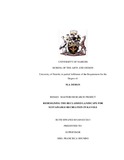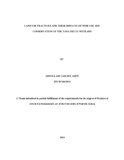Location
Our Vision is to be a world-class university committed to scholarly excellence.
Our Mission is to provide quality university education and training and to embody the aspirations of the Kenyan people and the global community through creation, preservation, integration, transmission and utilization of knowledge.
Core Values
In order to realize the above vision and mission, certain shared values shall be nurtured. There is great need for the University to be guided by the right values derived from the virtues and moral standards of the Kenyan and wider society.
Core Functions
Teaching and Learning: The university offers innovative , relevant and market driven academic programmes , both at undergraduate and postgraduate levels with inbuilt quality control systems the university also provides an environment and policy framework for undertaking high quality and relevant research
Members:
Resources
Displaying 41 - 45 of 298Redesigning the reclaimed landscape for sustainable recreation in Kayole
In the past mines were abandoned after mining activities leaving undesired effects on the landscape and water sources. Numerous accidents occur in quarries across Kenya leading to deaths of 30 people annually. Mining is an activity presenting a plethora of environmental, social and economic problems thus using abandoned quarries as sites for new construction is a useful form of reclamation, one that has occurred throughout history.
The Role of the Kenya Forest Service in the Management of Land Degradation and Environmental Conflict in the Mau Forest Complex
There is correlation on land degradation in reference to environment conflict against natural
resources undocumented. Environmental conflicts mostly depend over human needs and issues
such as distribution, allocation and natural resources management. History documents show how
resource-based conflicts had contributed to highly destructive wars at Karamoja and Kagera
regions of Uganda, Darfur in Sudan, in Rwanda genocide and even in the Niger Delta. Mau
Forest Complex is Kenya’s important water tower. Important rivers that deplete in to Lake
Community empowerment through participatory resource assessment at Kathekakai settlement scheme, Machakos County, Kenya
Participatory mapping is a power tool in resource management. Through this exercise communities are able to identify changes in natural resources and make decision on how best to manage the change. The study analyzed changes in natural resources in Kathakakai settlement scheme, Machakos County using participatory resource mapping, with the aim to discuss possible effects. The area, which used to be a ranching enterprise for nearly a hundred years, was sub divided in 1995 into individual farm holdings with average farm size of 2.5 hectares per household.
Land cover dynamics in the Chyulu watershed ecosystem, Makueni-Kajiado counties, Kenya
The aim of the study was to assess the state of land cover dynamics in the Chyulu Hills watershed ecosystem of Makueni and
Kajiado Counties in Kenya by considering the following objectives:- a) assessing the state of land cover in 2015, b) analysing
and characterizing land cover transformations in the watershed in 1987, 2001 and 2015, and, c) comparing the forest cover
dynamics with those of other studies in Kenya. The forest cover change analysis was undertaken through remote sensing and
Land Use Practices And Their Impacts On Wise Use And Conservation Of The Tana Delta Wetland
Globally, wetlands are under serious threat from the continuous reclamation due to demand to
satisfy human development needs. Wetlands are the worlds’ most productive environment and
rich in biological diversity of plants and animals. Wetlands provide many ecosystem services to
humans and the environment ranging from fresh water, food, regulation of climate, coastal
protection, regulation of floods, tourism and recreational activities, and water purification.
Despite the mounting recognition of the need to protect wetlands, many continue to be





